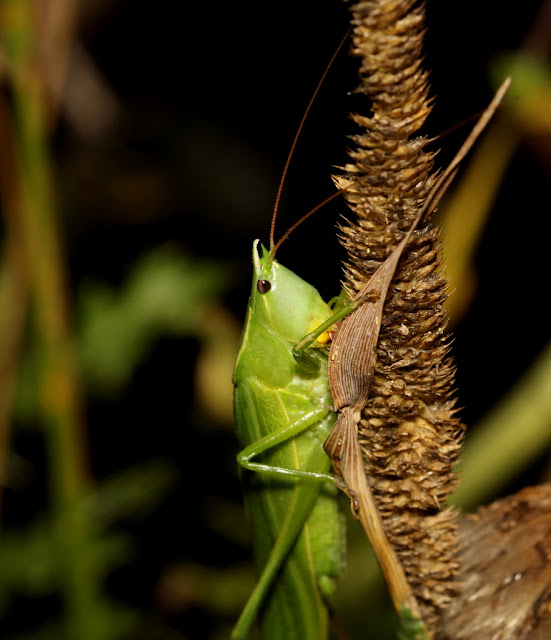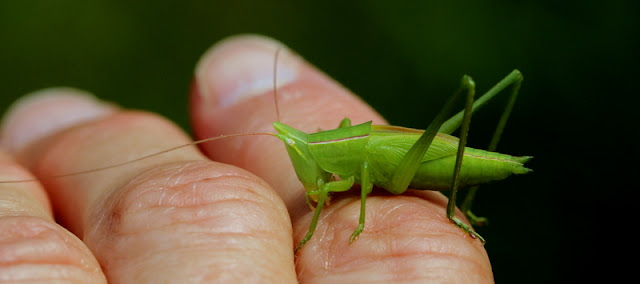Whenever I do an outdoor program, coneheaded katydids are the most popular of all the singing insects. They are absolute show stoppers!
Up here in NE Ohio, chances are excellent the singer will be a Sword-bearing Conehead. I’ve written about them here.
The more recent arrivals from southern Ohio – Round-tipped Coneheads (Neoconocephalus retusus) – are becoming increasingly likely up here as well. These coneheads are less tolerant of humans, though, and don’t hesitate to fly away in addition to the usual conehead escape of dropping down into the grasses.
The more of Ohio I explore, the more coneheads I get to know. As one goes west or southwest of Cleveland, Nebraska Coneheads (Neoconocephalus nebrascensis) become very common in open areas. They occasionally show up farther northeast, but I rarely hear them east of Cleveland.
Nebraska Coneheads are delightfully obnoxious. Their songs are loud and very easy to identify. It just gets a little…well… tedious after a while. I think it’s due to the rhythmic repetition combined with the abrasive tone quality (and, of course, the fact that it’s loud). Here’s a recording and sonogram:
When I record other singing insects in Nebraska Conehead country, I can always hear them in the background. Listen to this recording of Common True Katydids on Kelleys Island in western Lake Erie: can you hear the Nebraska Coneheads in the background?
The Nebraska Coneheads almost completely wiped out the Confused Ground Crickets I attempted to record.
All conehead species can be green or brown (though to date, I have never seen a brown Sword-bearing Conehead). I’ve wondered about those brown coneheads. Conehead nymphs are green, like this adorable little one:
I recently found some fascinating and very helpful information on the Singing Insects of North America (SINA) web site under “Coneheaded Katydids.” I read that “…all early juveniles of Neoconocephalus and Belocephalus are green, a few become brown during molts to late juvenile instars, and the majority of those that become brown adults change during the final molt.”
So a green nymph can molt into a green OR a brown adult! Only once have I seen a brown late juvenile nymph, and here he is:
And why are there two color possibilities?
Their habitats are typically a mix of brown and green. Later in the season, there’s much more brown than green in their habitats and the brown ones blend beautifully. Look at this brown Round-tipped Conehead:

According to SINA, a predator who captures a green conehead will likely continue searching for green ones. A brown one may be overlooked as a result. It’s difficult to search for two different colors at the same time, and I can testify that it takes a lot of effort. They’re hard enough to spot even when they're all green!
I’ve seen both green and brown Nebraska Coneheads now, and I’ve probably found more brown Round-tipped Coneheads than green ones. In fact, I've even had both colors within a few feet of each other!
And now, there’s this one.
I thought it might be a Robust Conehead (Neoconocephalus robustus), but no. It’s a False Robust Conehead (Neoconocephalus bivocatus).
I first encountered this species up in the northland of Geauga County. My friend and conehead collaborator Linda Gilbert had discovered this species singing along a fence line at the edge of a corn field not far from her home. She thought it was a Robust Conehead, as did I. (The False Robust Conehead isn’t on the range map for this far north in Ohio.) Here's one of Linda's photos:

When I heard multiple coneheads singing a similar song at Buzzard’s Roost Nature Preserve near Chillicothe, OH, I again thought, “Robust Conehead?”
And again, it was the False Robust Conehead – but in brown concert attire this time.
Multiple conehead species, different color forms…but they’re all show stoppers when people see them for the first time!












No comments:
Post a Comment